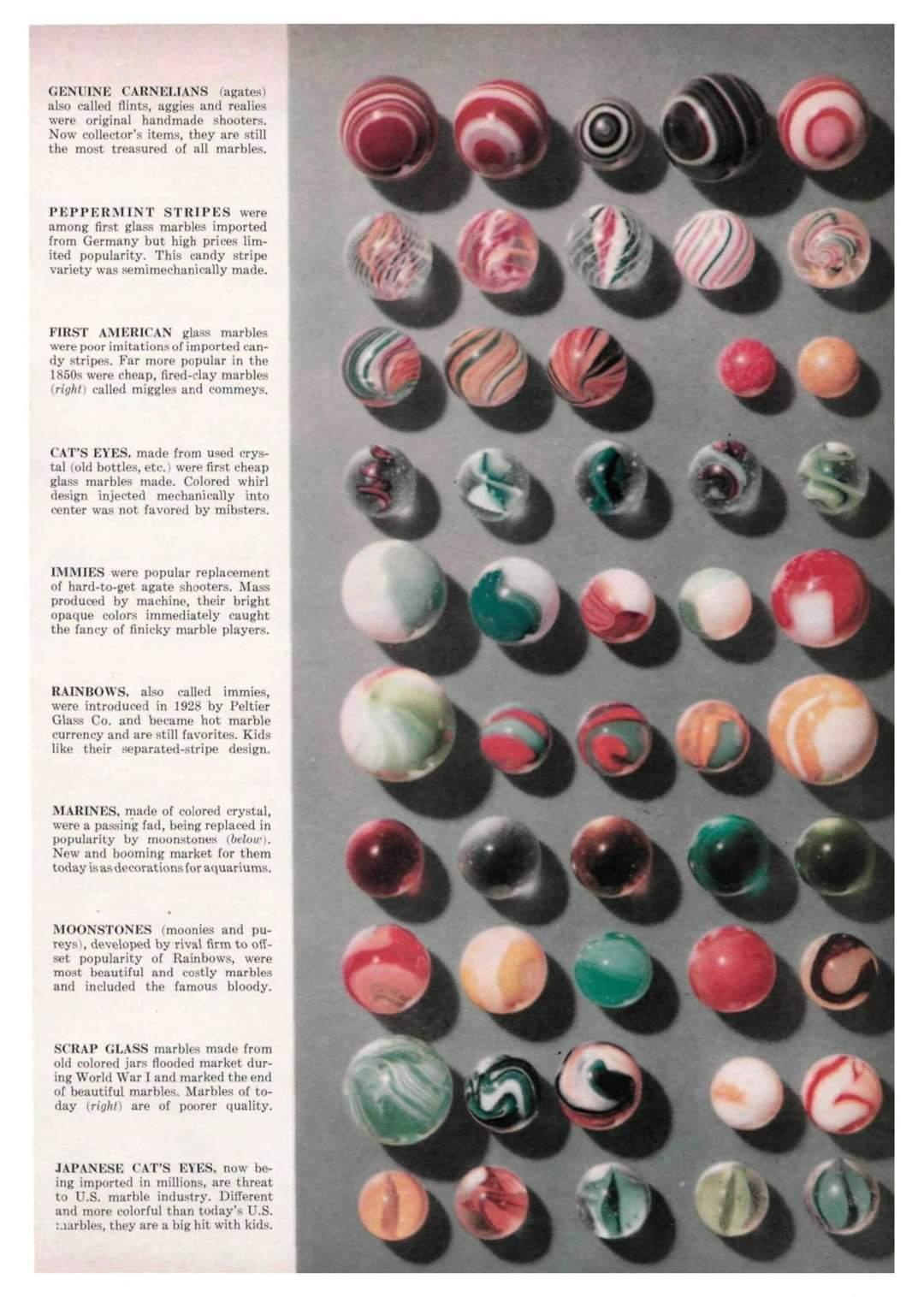1955 Sports Illustrated Marble Guide
Genuine Carnelians (agates)
also called flints, aggies and realies were original handmade shooters. Now collector's items, they are still the most treasured of all marbles.
Peppermint Stripes
were among first glass marbles imported from Germany but high prices limited popularity. This candy stripe variety was semi-mechanically made.
First American
glass marbles were poor imitations of imported candy stripes. Far more popular in the 1850s were cheap, fired-clay marbles (right) called miggles and commeys.
Cat’s Eyes
made from used crystal (old bottles, etc.) were first cheap glass marbles made. Colored whirl design injected mechanically into center was not favored by mibsters.
Immies
were popular replacement of hard-to-get agate shooters. Mass produced by machine, their bright opaque colors immediately caught the fancy of finicky marble players.
Rainbows
also called immies, were introduced in 1928 by Peltier Glass Co. and became hot marble currency and are still favorites. Kids like their separated-stripe design.
Marines
made of colored crystal, were a passing fad, being replaced in popularity by moonstones (below). New and booming market for them today is as decorations for aquariums.
Moonstones
(moonies and pureys), developed by rival firm to offset popularity of Rainbows, were most beautiful and costly marbles and included the famous bloody.
Scrap Glass
marbles made from old colored jars flooded market during World War I and marked the end of beautiful marbles. Marbles of today (right) are of poorer quality.
Japanese Cat’s Eyes
now being imported in millions, are threat to U.S. marble industry. Different and more colorful than today's U.S. marbles, they are a big hit with kids.
Genuine Carnelians (agates)
also called flints, aggies and realies were original handmade shooters. Now collector's items, they are still the most treasured of all marbles.
Peppermint Stripes
were among first glass marbles imported from Germany but high prices limited popularity. This candy stripe variety was semi-mechanically made.
First American
glass marbles were poor imitations of imported candy stripes. Far more popular in the 1850s were cheap, fired-clay marbles (right) called miggles and commeys.
Cat’s Eyes
made from used crystal (old bottles, etc.) were first cheap glass marbles made. Colored whirl design injected mechanically into center was not favored by mibsters.
Immies
were popular replacement of hard-to-get agate shooters. Mass produced by machine, their bright opaque colors immediately caught the fancy of finicky marble players.
Rainbows
also called immies, were introduced in 1928 by Peltier Glass Co. and became hot marble currency and are still favorites. Kids like their separated-stripe design.
Marines
made of colored crystal, were a passing fad, being replaced in popularity by moonstones (below). New and booming market for them today is as decorations for aquariums.
Moonstones
(moonies and pureys), developed by rival firm to offset popularity of Rainbows, were most beautiful and costly marbles and included the famous bloody.
Scrap Glass
marbles made from old colored jars flooded market during World War I and marked the end of beautiful marbles. Marbles of today (right) are of poorer quality.
Japanese Cat’s Eyes
now being imported in millions, are threat to U.S. marble industry. Different and more colorful than today's U.S. marbles, they are a big hit with kids.
1955 Sports Illustrated Marble Guide
Genuine Carnelians (agates)
also called flints, aggies and realies were original handmade shooters. Now collector's items, they are still the most treasured of all marbles.
Peppermint Stripes
were among first glass marbles imported from Germany but high prices limited popularity. This candy stripe variety was semi-mechanically made.
First American
glass marbles were poor imitations of imported candy stripes. Far more popular in the 1850s were cheap, fired-clay marbles (right) called miggles and commeys.
Cat’s Eyes
made from used crystal (old bottles, etc.) were first cheap glass marbles made. Colored whirl design injected mechanically into center was not favored by mibsters.
Immies
were popular replacement of hard-to-get agate shooters. Mass produced by machine, their bright opaque colors immediately caught the fancy of finicky marble players.
Rainbows
also called immies, were introduced in 1928 by Peltier Glass Co. and became hot marble currency and are still favorites. Kids like their separated-stripe design.
Marines
made of colored crystal, were a passing fad, being replaced in popularity by moonstones (below). New and booming market for them today is as decorations for aquariums.
Moonstones
(moonies and pureys), developed by rival firm to offset popularity of Rainbows, were most beautiful and costly marbles and included the famous bloody.
Scrap Glass
marbles made from old colored jars flooded market during World War I and marked the end of beautiful marbles. Marbles of today (right) are of poorer quality.
Japanese Cat’s Eyes
now being imported in millions, are threat to U.S. marble industry. Different and more colorful than today's U.S. marbles, they are a big hit with kids.
0 Comments
0 Shares
395 Views

